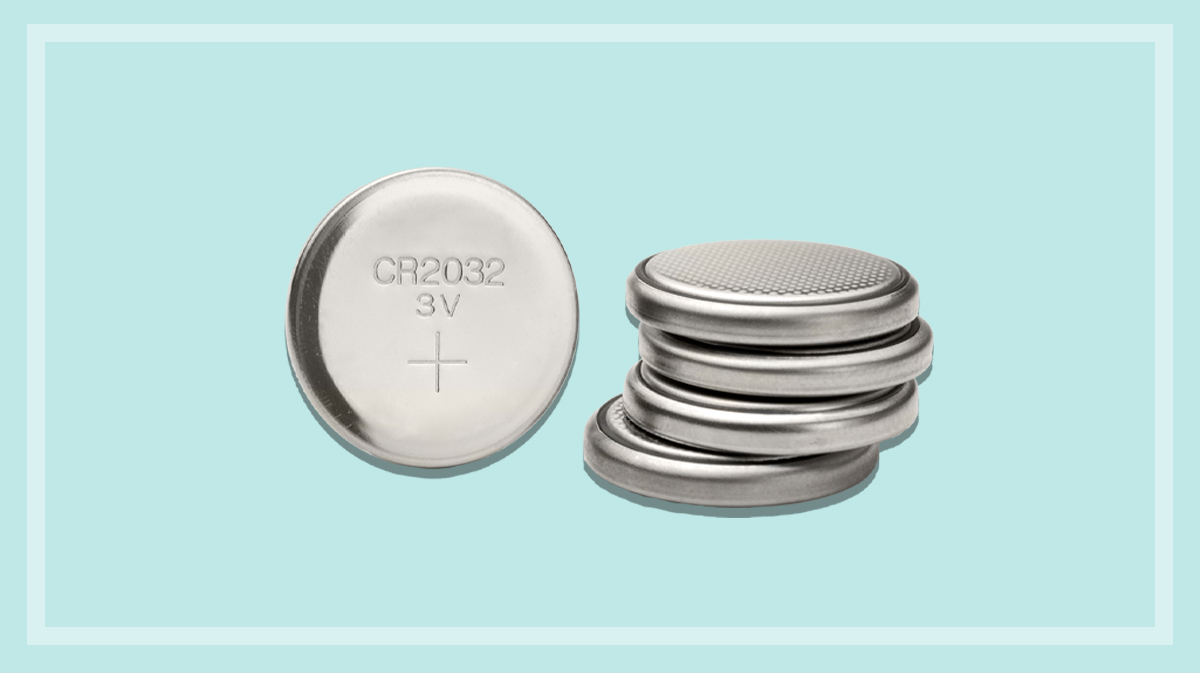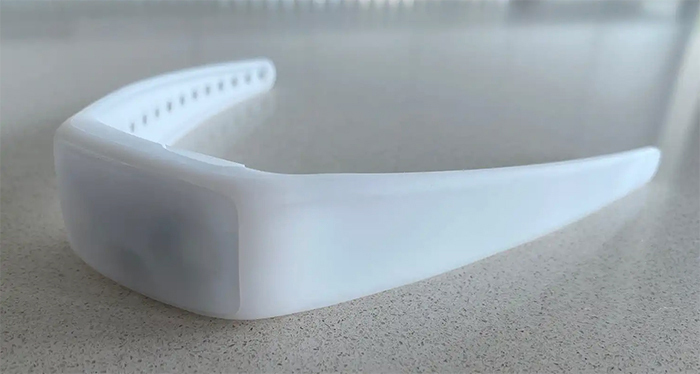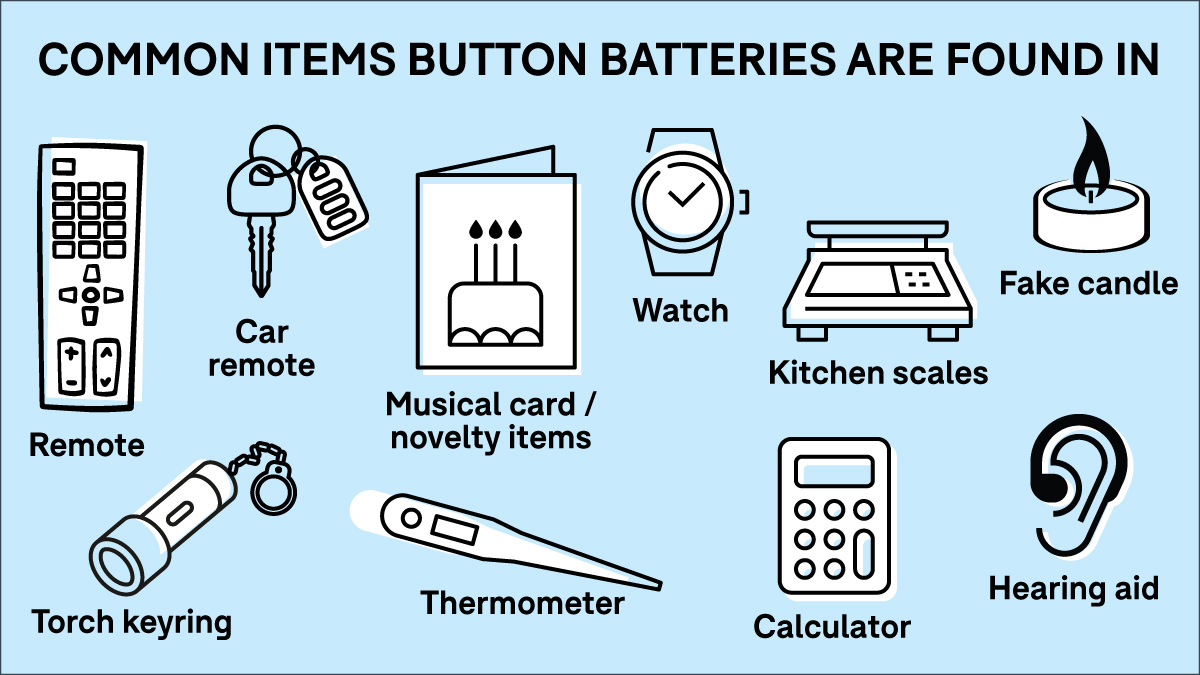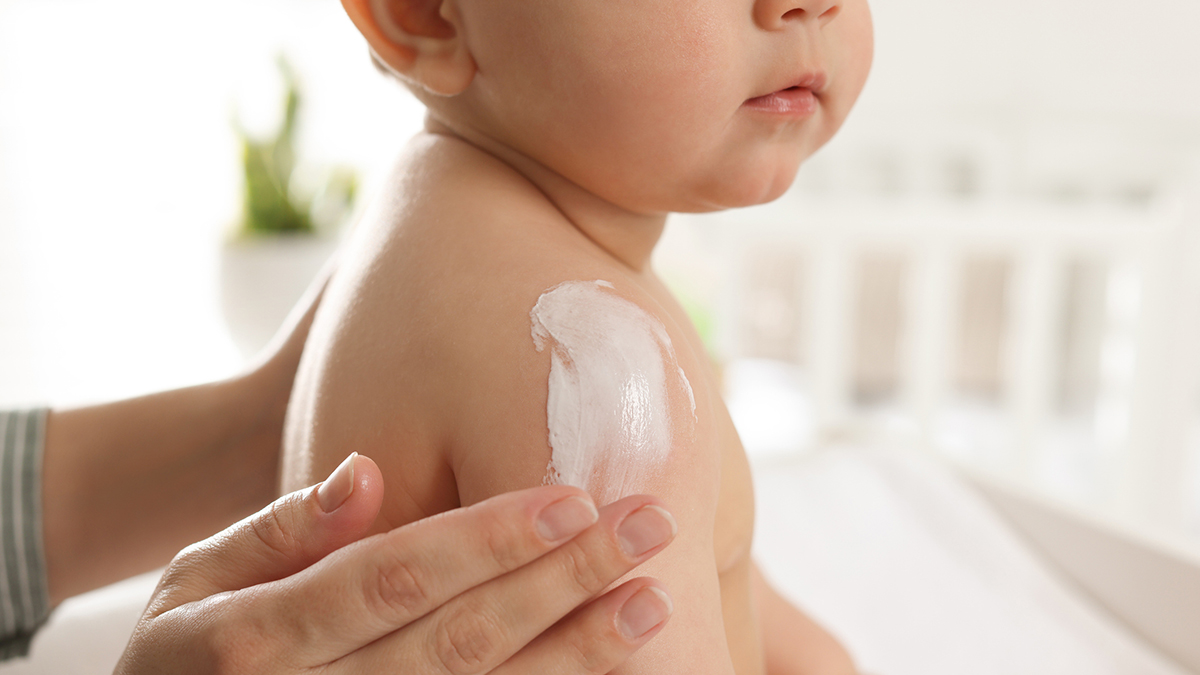Get our independent lab tests, expert reviews and honest advice.
The hidden dangers of button batteries

Notification: In December 2020, after years of campaigning by CHOICE and other organisations, the Australian government introduced mandatory safety standards for button batteries. This standard will help prevent children from gaining access to the batteries which, if swallowed, can be lethal. Manufacturers, suppliers and retailers have been given 18 months to comply with the new standards.
The devastating news broke this week of another death caused by button battery ingestion.
Three-year-old Brittney Conway died in July after swallowing a button battery which became lodged in her oesophagus, burning a hole through to her aorta.
This latest tragedy means that three children have now died in Australia since 2013 and many more have been seriously injured after ingesting a button battery.
So why are they still so easily accessible to young children?
New button battery tragedy
Queensland toddler Brittney had been complaining of a sore throat and a pain in her chest and also suffered vomiting and a nosebleed. Despite multiple presentations to medical services, none of the doctors who examined Brittney suspected button battery ingestion and she was mistakenly diagnosed first with food poisoning, then a virus.
Nine days after Brittney first complained of a sore throat, her parents found her unconscious in a pool of blood. She was rushed to hospital where she underwent surgery to try to repair the damage, but died of her injuries days later.

AFL Grand Final wristbands a danger
The day after the news of Brittney’s death broke, flashing wristbands containing button batteries were handed out to the 30,000 spectators at the AFL Grand Final.
Each band contained two 3V lithium button batteries, which could be easily removed from the battery compartment. These wristbands, along with thousands of unsecured and potentially deadly button batteries, have now made their way into unsuspecting households.
From the moment it was designed, it was destined for landfill, if it doesn’t kill a child on the way
Dr Ruth Barker, Director of the Queensland Injury Surveillance Unit (QISU)
Paediatric emergency doctor and Director of the Queensland Injury Surveillance Unit (QISU) Dr Ruth Barker has been working on this issue for 10 years and is frustrated by the industry’s slow progress.
“How shallow are we as a species that we prioritise two hours of flashing lights over child safety,” she says. “This item is cheap as chips and from the moment it was designed, it was destined for landfill, if it doesn’t kill a child on the way.”

The problems with button batteries
Most button batteries are smaller than a five-cent piece, but the physical damage they can cause can be fatal.
There are a number of elements that make button or disc batteries a particular safety problem compared to other batteries:
Size
Button batteries come in various sizes. The smaller batteries can be easily inserted into children’s ears or nostrils, while the larger 20mm batteries are most likely to become lodged in the oesophagus (foodpipe) if swallowed.
Design
The battery poles are close together, making it easy for an electrical charge to flow when they are placed in a saline (saltwater) environment such as the human body. This electrical current breaks down water in a process called hydrolysis, producing hydroxide ions. It is these ions (not the leaking battery acid) which causes severe internal burns.
Dangerous even when flat
A 3V lithium battery can still cause damage when it no longer contains enough charge to power a device. These batteries will stop working at about 1.5 volts, but it only takes 1.2 volts to cause internal burns.
They go down easily and they don’t hurt
Many children can swallow a disc battery without choking or coughing, which means unless someone sees them do it, parents or carers will be none the wiser. Kidsafe Queensland CEO Susan Teerds says the smooth, shiny look and feel is also particularly appealing to younger children who like to put things in their mouths. Soft tissue in the oesophagus and gut doesn’t register pain very well, so the battery can burn severely without clear symptoms.
The symptoms are varied
If a child has swallowed a battery, they’re unlikely to tell anyone.The peak age for battery ingestion is 12–24 months, a time when young children are only just acquiring language skills. Older children, particularly those on the autism spectrum, also swallow them, but can be reluctant to say anything for fear of getting in trouble.
Between them, the three children who have died from button battery ingestion were mistakenly diagnosed with Giardia, a virus, a urinary tract infection and food poisoning
Once the battery starts to burn, the symptoms can range from feeling ill and grizzly to having a mild cough – which can all be easily written off by parents or medical personnel as something else. Between them, the three children who have died in Australia from button battery ingestion were mistakenly diagnosed with Giardia (a parasitic illness that causes vomiting and loose bowels), a virus, a urinary tract infection and food poisoning.
Dr Barker says, “These injuries cast long shadows, they are caustic injuries. Scar tissue resulting from burns in the oesophagus doesn’t stretch or grow and has to be treated regularly under anaesthetic.”
Safety tips
The ACCC recently launched a new safety campaign, urging parents and carers to be aware of the serious risks associated with button batteries.
They can be found in any number of common household appliances, including bathroom scales, hearing aids, reading lights, cameras, flameless candles, games and toys, watches, calculators, torches and laser lights, thermometers, remote control devices that unlock cars and control MP3 speakers and musical greeting cards.
In 2019, CHOICE testing found that 10 out of 17 common household products contained button batteries that could easily be accessed – and swallowed – by children.

To keep your child safe from the danger they pose, follow these safety tips:
- Reduce the number of products in your home that are powered by button batteries. Although injury can still occur with cylindrical batteries, it is much less common. Where possible, opt for products powered by alternative batteries or power sources, or those with enclosed batteries (USB rechargeable).
- Secure button batteries and the products they power. Only purchase button batteries in child resistant packaging. Products containing button batteries should be durable, with child-resistant battery compartments that will not open if dropped.
- Know which products in your home contain button batteries. Regularly check that the battery is still secured in the child-resistant compartment. Where you can, keep them out of reach of small children (and be mindful that children often climb furniture to access higher areas).
- Dispose of spent and unused batteries immediately and safely – ‘flat’ batteries are still dangerous. Wrap both sides with sticky tape when you take them out of the product. This reduces the fire risk if you are storing them for recycling and makes them trickier to swallow.
- Recognise the signs and symptoms of occult ingestion; gagging, drooling, unable to eat properly, noisy breathing, chest pain (grunting), vomiting or passing black or red blood in stools.
- Respond immediately if you suspect someone has swallowed or inserted a button battery. Not every health facility has the capacity to assess or manage a button battery injury, so call the Poisons Information Centre first on 13 11 26 (24/7) for fast expert advice.
- Warn others about the dangers of button batteries.
20 children a week is 20 too many
In Australia, three children have now died after swallowing a button battery. Product Safety Australia estimates that 20 children a week are presenting at emergency departments nationwide suspected of having swallowed or inserted a button battery.
In some cases, X-rays show that a battery has not been swallowed, or it has safely passed into the small bowel. However, a small proportion of these children have severe injuries, most commonly those who have delayed presenting to a medical facility, or haven’t been able to reach a paediatric centre where the battery can be removed quickly enough.
Queensland Health has funded a national surveillance program to collect data on the nature of these severe button battery related injuries. The program has been running for 34 months and has identified 44 cases with a wide range of outcomes.
Some children are able to have the battery removed within a couple of hours and sustain only mild burns. This is usually the case when the battery exposure was identified immediately and the child was able to present to a speciality paediatric centre quickly. However, in cases like Brittney’s, where the family did not know she had swallowed the battery, the injury at the time of battery removal is so severe that recovery is not possible.
They are everywhere now. Even if you don’t think you have any in your home there’s a good chance you’re mistaken
Susan Teerds, Kidsafe Queensland CEO
Currently, only toys designed for children under three years of age are required by law to have child-resistant battery compartments. This means that many everyday household items that contain button batteries – including car keys, baby thermometers and remotes – have no mandatory safety standards and the batteries can be accessible to young children.
That’s why we’re calling on the government to act and introduce mandatory safety standards covering all items containing button batteries, including that:
- all button battery-powered products must have a child-resistant battery compartment,
- button batteries of up to 32mm diameter must be sold in child-resistant packaging,
- for products supplied with a button battery, batteries must be secured within the battery compartment and not loose in the product packaging,
- products that use or contain button batteries have clear and concise warnings, making the risk clear to consumers at point of purchase (including online sales).
Teerds says the proliferation of products containing button batteries is alarming: “They are everywhere now. Even if you don’t think you have any in your home there’s a good chance you’re mistaken.
“You might not have bought them – but they are given to you in loads of promotional items and products like car key fobs and flashing Santa hats.”
How much damage a button battery can do
Case studies
While the news of a young child dying from swallowing a button battery is devastating, those who survive come out far from unscathed, as the resulting physical damage is often severe and long term.
Hunter, a one-year-old boy, swallowed a lithium battery, which burnt a large hole in his oesophagus and trachea leaving him unable to swallow his own saliva.
As a result he has endured 10 operations so far to try to repair the damage. Many children can’t swallow or eat for years afterwards, and it can be life-changing.
“While they are lucky to survive, life won’t be the same,” says Barker. (See Sarah’s story below to find out how one victim is coping three decades on.)
In 2013, four-year-old Summer Steer was effectively a walking time bomb when she swallowed a button battery without anyone noticing.
It was only when Summer’s mother noticed that her little girl was producing dark-coloured stools that she took her to a doctor, who diagnosed her with Giardia.
Summer was still playing, eating and drinking for the majority of the fortnight after she swallowed the battery, but eventually the little girl started vomiting blood. In hospital, she was wrongly diagnosed with a bloody nose and sent home.
After two more hospital visits Summer’s condition deteriorated severely, and it was only when she was fitted with an oxygen tube in hospital using an X-ray that an object was discovered lodged in her throat.
Despite the discovery, medical professionals decided the object would be removed once she was flown to Brisbane from Noosa. In Brisbane she was rushed into surgery, where it was discovered that the object was a lithium battery. She died shortly after.
An inquiry was held after Summer’s death, and despite investigations it was never clear where the battery she swallowed had come from.
Susan Teerds says, “Even if you don’t have kids these things are everybody’s problem. If you don’t lock them down and dispose of them properly, you are part of the problem.”
In 1985, Patricia Preston’s baby daughter Sarah swallowed a ‘flat’ lithium button battery she found in a box in the camera shop her mum was working in. The battery went down easily, and Patricia was none the wiser.
Preston says later that day the nine-month-old had an unusual cry and seemed a bit off. She called the local hospital and was told Sarah would be fine. Unconvinced, the next day she made the 80km trip to hospital, where she was told that the baby had croup.
Preston stayed up all night with her baby, who by this time had started passing dark stools “like squid ink”. Panicked, she headed to her mum’s home in Sydney.
Preston’s mother (who was a nurse) took Sarah to Westmead Children’s Hospital, where she was again diagnosed with croup and made to wait for six hours. She was eventually X-rayed, but the foreign object found in her throat was mistaken for a coin. After a long wait she was taken into surgery, and it was then that the surgeons discovered the ‘coin’ was in fact a button battery.
The battery had burned a hole in Sarah’s trachea and she suffered a lung collapse. As a result of her injuries she was unable to eat and was fed through a tube in her stomach for two years. Preston says that even as an adult Sarah still has problems swallowing, and suffered developmental delays after extended time in hospital.
While Preston says she was lucky she found doctors who were prepared to investigate her baby’s problem, she finds it hard to comprehend that what she and Sarah went through is still an issue three decades later.
“Here we are all these years later and I see so many parallels between what happened with me and Sarah, and [what happened to] Summer Steer.”
In February 2015, 14-month-old Bella Rees became the second child in Australia to lose her life after swallowing a button battery which became lodged in her oesophagus.
Bella first presented to hospital in January, when she became unwell and started vomiting after a trip to the park. She was diagnosed with a virus and sent home, but over the following days, her symptoms worsened. Bella became feverish and lethargic and was refusing food.
When her mother Allison Rees noticed that she was producing black stools, she took Bella back to hospital. This time she was diagnosed with a urinary tract infection and sent home with a prescription for antibiotics.
Bella continued to refuse food and produce dark stools, prompting her parents to return her to hospital for a third time. But after checking her temperature and blood pressure – both of which were normal – Bella was sent home once again.
On 4th February 2015, Allison woke to the sound of Bella coughing, and discovered her sheets were saturated with blood. She was rushed to the hospital where an X-ray revealed a round object lodged in her oesophagus. Initially mistaken for a 10-cent coin, the object was later identified by the coroner as a button battery. Bella died shortly after, despite resuscitation efforts.
An inquest was held into Bella’s death, and in her report coroner Caitlin English offered her support for the introduction of a General Safety Provision into Australian Consumer Law (ACL), stating that, “Such a law would impact on design, sourcing and supply of unsafe consumer products including button batteries and products that contain them, and incentivise their safe supply.”
The coroner also noted the tireless efforts of Bella’s family in the work they do to prevent further deaths and injuries from button battery ingestion.
What about regulations?
In August 2019, the ACCC established a Button Battery Taskforce to investigate regulatory options to improve the safety of button batteries and products that contain them.
The Taskforce is considering a proposed new mandatory standard which would require that:
- products containing button batteries have secure battery compartments
- button batteries are sold in child-resistant packaging
- warnings and information must be present on the packaging and instructions of the batteries and products containing button batteries, as well as at point of sale.
The outcomes of the Taskforce’s investigation are due to be announced at the end of 2020.
This step towards enforceable regulation, in the form of a mandatory standard, comes in response to the low uptake of the voluntary Industry Code for Consumer Goods that Contain Button Batteries, which was released in 2016.
Reluctance and loopholes
While the 2016 voluntary standard suggests a number of safety mechanisms designed to reduce the risk of button batteries to the community, regulators have identified the industry’s failure to implement them. The dangerous wristbands given out to spectators at the AFL grand final are a perfect example of this.
“While many companies haven’t done anything, some companies have complied by sealing the battery compartment with a simple screw,” says Dr Barker. “But for poorly made products, the battery can still be released if the product is dropped or the screw can pull out easily.
“For example, a young boy was severely injured when he swallowed a battery from an artificial tea light with a screw closure that was given to his sibling at kindy.
“When the tealight came home, it was dropped, the battery fell out and he swallowed it. He lives three hours from Brisbane, so by the time the battery was removed, he had a severe burn.”
Any parent can tell you that kids will play with anything… So it is complete nonsense that only toys require this level of protection
Dr Ruth Barker
Toys for children under 36 months, under mandatory regulations, are required to have child-resistant battery compartments and pass impact/drop testing. Other items marketed with disclaimers such as ‘this is not a toy’ don’t need to pass this test but can be attractive and sometimes fatal in the hands of a toddler.
As Dr Barker points out, this rule is shortsighted.
“Any parent can tell you that kids will play with anything. The child defines the toy. So it is complete nonsense that only toys require this level of protection.”
Consumer law oversight?
Dr Barker says many Australians would be shocked that so many products in the Australian market have not been tested to any safety standard. “Too many preventable injuries have been caused by products that are poorly designed.”
She wants a general safety provision added to the ACL, which would require companies to ensure that the products they sell are safe.
“Under the current ACL, products are required to be ‘safe and fit for purpose’, but it is not clear what that means on a practical level,” says Dr Barker.
There is no general requirement under [Australian] law that products sold be safe. This is startling – most people would assume that our law requires goods to be safe before they are sold
Amy Pereira, CHOICE policy advisor
CHOICE policy advisor Amy Pereira says there are surprising gaps in Australia’s consumer law.
“While the Australian Consumer Law provides strong protections for consumers who experience problems with products, there is no general requirement under the law that products sold be safe,” she says. “This is startling – most people would assume that our law requires goods to be safe before they are sold.”
Button batteries are a perfect example of this oversight.
“While there are rules requiring that button batteries in toys (for children under 36 months) be properly secured, these rules do not apply to other products,” she says.
Pereira says that the current system of rules is complicated, and it’s leading to injuries and deaths.
“A simpler option would be to amend the law to require that all products sold be safe,” she says.
The importance of product safety
Dispose of carefully
What makes the larger (usually lithium) button batteries particularly dangerous is that even when they are ‘flat’ and can no longer power your device, they still contain enough charge to burn if they’re ingested. As a result, careful disposal is critical, and that doesn’t mean your bin is a safe place either.
There are some recycling facilities available for lithium and alkaline batteries and this is the safest place for them to go, but you still need to exercise caution because button batteries stored together can cause a fire. Use sticky tape to cover the battery on both sides as soon as you remove it from a product to reduce the risk of fire and make the battery more difficult for children to insert or ingest. For more information on how and where to dispose of your button batteries head to batteryrecycling.org.au.
[If you] don’t dispose of it safely then it could end up in the hands of a child anyway. You wouldn’t do that with a loaded gun, so why would you do it with one of these batteries?
Susan Teerds
And if recycling sounds too hard, Teerds has some harsh reminders for anyone who is in possession of a button battery.
“This is everyone’s problem, we have children being injured and dying,” she says. “If you don’t have a child you might think ‘this doesn’t affect me’, but if you throw it out of the window of your car, or don’t dispose of it safely then it could end up in the hands of a child anyway.
“You wouldn’t do that with a loaded gun, so why would you do it with one of these batteries?”





